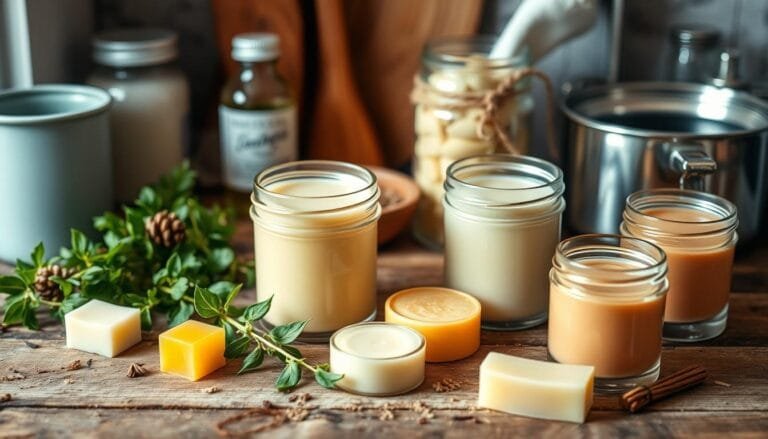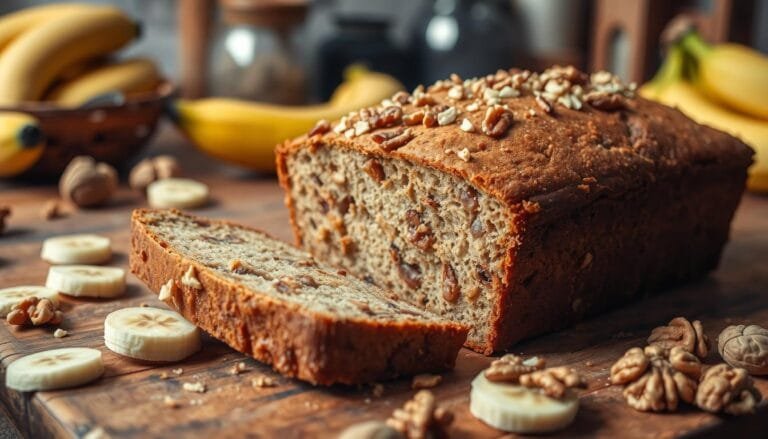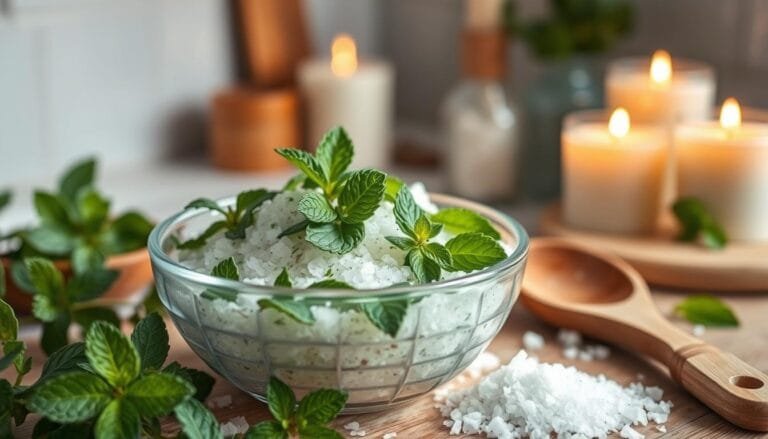I’m passionate about natural health and wellness. I’ve always been drawn to homemade healing ointments. They offer a fresh alternative to traditional treatments, using ingredients from our kitchens and gardens.
These ointments help with pain, inflammation, skin issues, and minor wounds. Turmeric, for example, has been used for 4,000 years in Ayurvedic medicine.
In this article, I’ll share how to make effective, all-natural ointments at home. Whether you need relief from arthritis, skin irritations, or wound healing, these DIY remedies can help. Let’s explore the world of homemade healing ointments and natural ingredients that can improve your health and wellness.
Understanding the Basics of Natural Healing Ointments
Topical herbal treatments are a favorite for natural healing remedies. They come in different forms, each with its own benefits. Let’s look at the types of natural ointments and why natural ingredients are good.
Different Types of Topical Treatments
There are three main types: infused oils, salves, and creams or lotions. Infused oils are made by soaking herbs in oils like olive or almond oil. This extracts the good stuff from the plants.
Salves mix these oils with natural waxes, making them thicker and more concentrated. Creams and lotions blend the oils with water, making them light and easy to spread.
Benefits of Natural Ingredients
Natural ingredients in these treatments are gentle yet effective. Herbs like calendula, comfrey, and turmeric are great for soothing skin and relieving pain. They’re good for eczema, sunburns, and muscle aches.
These natural remedies are also free from harsh chemicals. This makes them safer for sensitive skin.
Storage and Shelf Life
Storing your homemade herbal ointments right is key to keeping them fresh. Keep them in a cool, dark place. Salves can last up to six months, and infused oils up to a year.
Stay away from direct sunlight and heat. This helps keep their strength and effectiveness.
Exploring topical herbal treatments is rewarding. It offers a natural way to tackle skin and health issues. By knowing the different types and the benefits of natural ingredients, you can make your own healing ointments.
Essential Equipment and Supplies for Making Homemade Healing Ointments
Making your own natural healing ointments at home needs a few key tools and supplies. Having the right equipment makes the process smooth and successful. This way, you can make high-quality, customized remedies. Let’s look at the main items you’ll need to start your homemade healing ointment journey.
Necessary Equipment
- Double boiler: This is key for safely melting and blending ingredients without burning them.
- Glass jars or metal tins: Sterile, airtight containers are essential for storing your ointments.
- Cheesecloth or muslin: These fabrics are great for straining herbal-infused oils and hydrosols.
- Blender or immersion blender: These tools help make smooth, creamy ointments and balms.
Crucial Measuring Tools
- Kitchen scale: Accurate measurements are vital for mixing ingredients right.
- Measuring cups and spoons: You can’t do without them for measuring liquids and solids precisely.
Also, have clean, sterilized containers ready for storing your DIY ointment tools and homemade remedy supplies. This keeps your natural creations fresh and of high quality.
“Preparation and organization are the keys to creating effective, safe, and consistent homemade healing ointments.”
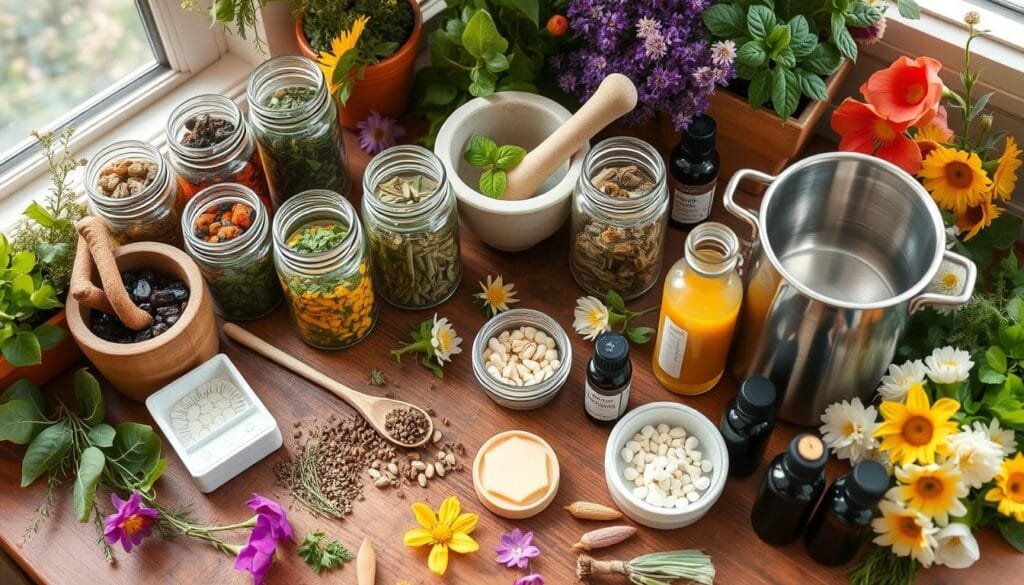
With the right DIY ointment tools and homemade remedy supplies ready, you’re set to make personalized, natural healing ointments. These can offer relief and nourishment for your skin and body.
Best Carrier Oils and Base Ingredients
Choosing the right carrier oils and base ingredients is key to making effective natural healing ointments. Carrier oils like olive oil, almond oil, and coconut oil moisturize and nourish the skin. Natural waxes and emulsifiers, such as beeswax, mix the oil and water phases, making the ointment smooth and stable.
Popular Carrier Oil Options
Here are some top carrier oils for DIY ointments:
- Coconut oil – It comes in refined and unrefined types. The unrefined version has a stronger scent and more nutrients.
- Jojoba oil – It’s similar to the skin’s natural oils, making it great for many skin types.
- Almond oil – It’s light and nourishing, easily absorbed by the skin, leaving it soft.
- Olive oil – Use extra-virgin olive oil for its antioxidants and fatty acids, making it versatile.
- Argan oil – Rich in vitamins and fatty acids, it’s known for its skin-rejuvenating properties.
Natural Waxes and Emulsifiers
Natural waxes and emulsifiers are vital for a stable ointment. Beeswax adds structure and texture, while soy wax is a vegan option. Emulsifiers like beeswax mix oil and water phases, making the ointment smooth and easy to spread.
Preservation Methods
Keeping homemade ointments fresh and safe is important. Adding vitamin E oil or rosemary extract can help them last longer. Store them in cool, dark places to keep their quality and effectiveness.
Powerful Healing Herbs for Natural Remedies
Exploring medicinal herbs can reveal a wealth of natural healing options. These plants help soothe skin issues and ease pain. They offer a natural way to improve your health.
Calendula, with its bright orange flowers, is great for skin. It fights inflammation and bacteria, perfect for wounds and burns. Comfrey helps heal damaged tissues, making it great for natural ointments.
Arnica, a yellow-flowered herb, eases pain and swelling. Its anti-inflammatory properties are ideal for sore muscles and joints. Lavender calms the mind and body, helping with sleep and relaxation.
- Chamomile soothes skin and helps with digestion thanks to its anti-inflammatory effects.
- St. John’s Wort is known for easing nerve pain and improving mood.
- Turmeric and ginger are powerful against inflammation. They can be used in homemade pain relief balms.
Other herbs like plantain, yarrow, and marshmallow root are also beneficial. They help with skin, wound healing, and digestion. Using medicinal herbs, herbal infusions, and healing plants can open up a world of natural remedies for better health.
Step-by-Step Guide to Making Basic Herbal-Infused Oils
Making your own herb-infused oils at home is rewarding and versatile. You can use them for skin care or cooking. You can choose from quick heat-infused or slow cold-infusion methods. This lets you tailor the blend to your needs.
Hot Infusion Method
The hot infusion method is fast. Start by mixing 4 ounces of dried herbs with 8 ounces of oil. Put them in a heat-safe container like a Mason jar. Then, place it in a water bath at 110°F for 3 to 5 days, stirring now and then.
Cold Infusion Method
The cold method is gentler and slower. Just put your dried herbs and oil in a jar, making sure the herbs are covered. Seal it and keep it in a cool, dark spot for 4 to 6 weeks, shaking it sometimes. This method keeps the herbs and oil’s delicate properties intact.
Straining and Storage Tips
After the infusion time, strain the oil. Use a mesh strainer or cheesecloth with a coffee filter. Slowly pour the oil through, throwing away the herbs. Put the oil in clean, airtight containers and keep them away from light and heat.
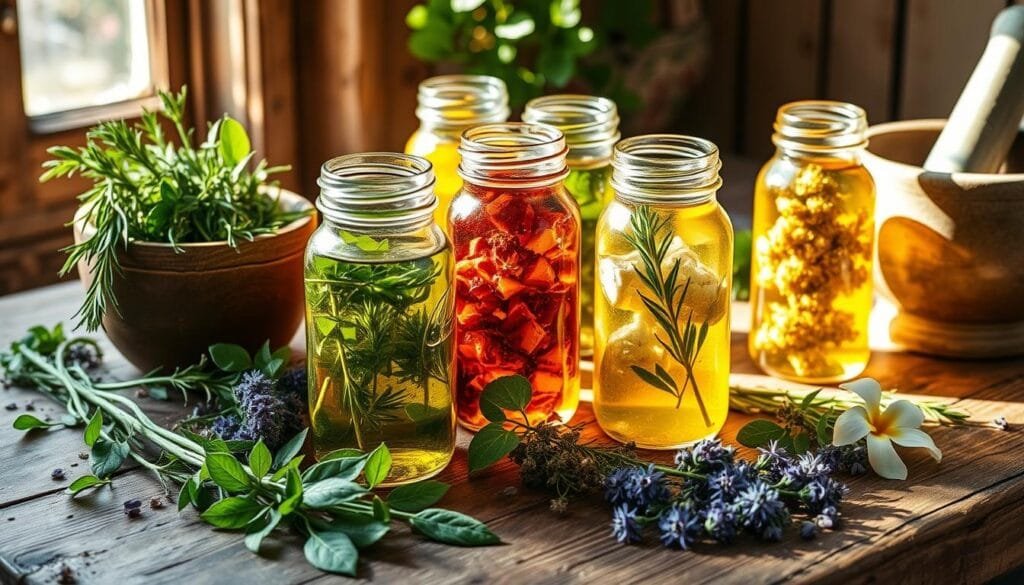
By following these steps, you can make a high-quality herb-infused oil. Use it in many oil infusion techniques and personal care products. Try different herbs to find your unique blends and enjoy nature’s healing remedies.
Creating Soothing Salves for Skin Conditions
Herbal salves are great for skin issues like redness, inflammation, and dryness. They mix oil and beeswax for cooling and nourishment. Olive oil is a top choice, but coconut and sunflower oils work too.
To make a soothing salve, you need certain herbs. I mix 2/3 cup each of dried comfrey leaf, plantain leaf, and calendula flowers. Then, I add beeswax to make 8 ounces of salve. A few drops of lavender essential oil help preserve it and add calmness.
Making salve involves blending herbs into powder, infusing them in oil, and mixing with beeswax. Pour it into tins or jars. Herbs like calendula, comfrey, and plantain help heal the skin, making this salve versatile.
- Plantain is a gentle antimicrobial herb that excels at soothing bug bites, cuts, scrapes, rashes, and blisters.
- Comfrey leaf is an emollient herb that moisturizes and nourishes the skin, aiding in the healing process of minor wounds.
- Calendula flowers have antimicrobial and wound-healing properties, suitable for soothing dry, itchy, and red skin conditions, preventing scar formation.
This homemade salve is great for many skin issues. It’s good for cuts, bruises, stings, poison ivy, skin irritations, diaper rash, baby skin issues, eczema, scrapes, abrasions, and insect bites. The herbs are naturally antibiotic, anti-inflammatory, anti-fungal, and astringent. This herbal salve recipe is essential for any natural first-aid kit.
For a scraped knee, irritated skin, or a bug bite, this skin-soothing balm offers quick relief and long healing. Its blend of herbs and oils is a game-changer for healthy, radiant skin naturally.
Anti-Inflammatory Balms with Turmeric and Ginger
Looking to ease inflammation and pain? Turmeric and ginger are your go-to ingredients. They’re known for their strong anti-inflammatory effects. This makes them great for a homemade healing balm.
Benefits of Turmeric in Topical Applications
Turmeric is a natural fighter against inflammation. Its active part, curcumin, has been studied a lot. It helps stop the production of inflammatory molecules. This means turmeric balms can help with arthritis, muscle soreness, and joint pain.
Proper Measurements and Mixing Techniques
To make a good turmeric balm or anti-inflammatory ointment, the right mix is key. Use 3 tablespoons of turmeric and ginger powder for every cup of carrier oil, like coconut or olive oil. Make sure to mix well so the active compounds are spread evenly.
- For best results, use 1/2 to 1 1/2 teaspoons of the balm daily.
- Adding ginger, another strong anti-inflammatory, can make the ointment even better.
- Think about adding a few drops of calming essential oils like lavender or eucalyptus.
With some prep and the right mix of natural ingredients, you can make a strong turmeric balm or anti-inflammatory ointment. It can help soothe your body and aid in natural healing.

Pain Relief Ointments with Essential Oils
Essential oils can change the game for natural pain relief. Oils like eucalyptus, peppermint, and wintergreen have amazing pain-relieving properties. They can soothe many types of aches and pains.
Eucalyptus oil has a compound called 1,8-cineole that works like morphine to ease pain. Peppermint oil relaxes muscles, great for headaches and sore muscles. Wintergreen oil has methyl salicylate, similar to aspirin.
To make your own pain relief ointments, mix essential oils with carrier oils like coconut, jojoba, or almond. Use at least 6 teaspoons of carrier oil for every 15 drops of essential oil to avoid skin irritation.
- Begin by mixing your chosen essential oils in a small glass bottle or jar.
- Add the carrier oil and stir gently to mix.
- For a roll-on, move the mixture to a roll-on bottle.
- Apply the ointment to the painful area, massaging it in gently.
- You can also add a few drops to a warm bath or use it in a compress for soothing relief.
Always do a skin patch test first to check for any reactions to the essential oils. And talk to your healthcare provider before trying new natural remedies, if you have any health conditions or are on medications.
“I used the DIY Pain Relief Cream and it was life-changing for my brain cancer recovery. The Restore Essential Oil Blend provided such soothing relief.” – Laura
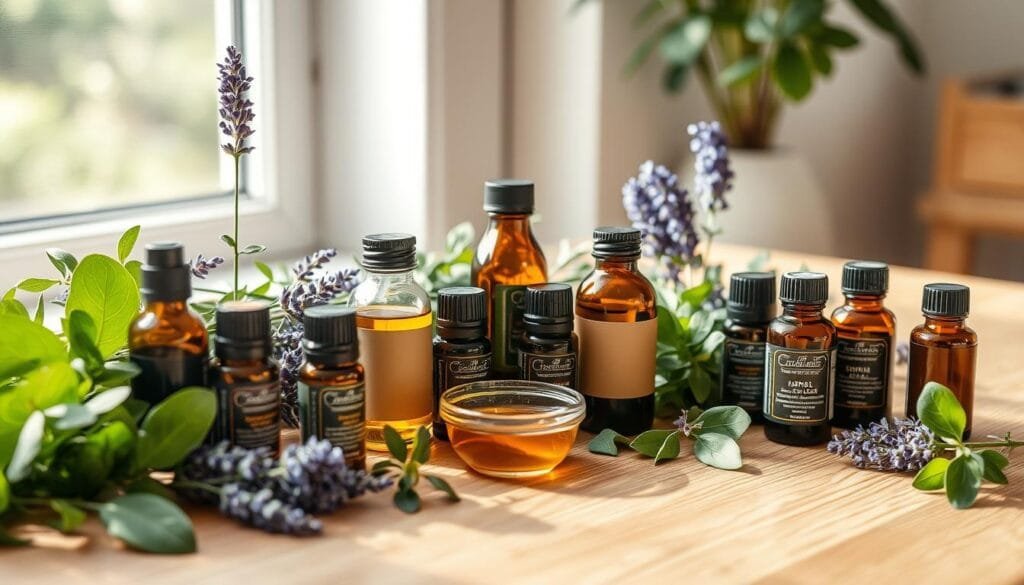
With the right essential oil ointments, you can find natural relief for many pains. From headaches and muscle aches to joint pain and menstrual cramps. Explore these options and start your journey to holistic healing today.
Natural Healing Creams for Burns and Scrapes
Minor burns or scrapes can be soothed with natural healing creams. These creams use plant-based ingredients like calendula and comfrey. You can make a burn relief cream at home.
Calendula and Comfrey Combinations
Using oils infused with calendula and comfrey makes a strong treatment for burns and scrapes. Calendula fights inflammation and helps wounds heal. Comfrey boosts new skin growth and speeds up healing.
Application and Treatment Guidelines
To make a healing cream, mix calendula and comfrey oils with aloe vera gel. Use 2/3 cup distilled water, 1/3 cup aloe vera gel, and 3/4 cup herb-infused oil. Add a few drops of tea tree essential oil for its antibacterial benefits.
Apply the cream gently. Don’t use it on deep or severe burns. For minor burns, apply a few times a day until healed. Always see a doctor for severe burns.
“Natural remedies like aloe vera, honey, and calendula can be effective in treating minor burns, but it’s vital to know the burn degree and seek medical care for severe cases.”
Natural ingredients can help make a soothing burn relief cream for natural wound care. Always follow the right application and seek medical help for severe burns or concerns.
Safety Considerations and Precautions
Using herbal remedies and natural ointments safely is very important. I always do a patch test on my skin before using new products. This helps prevent allergic reactions. I’m careful with essential oils like eucalyptus because they can cause problems for some people or pets.
It’s also important not to use essential oils without diluting them first. Pregnant women, children, and people with health issues should talk to a doctor before trying herbal remedies. Natural remedies might seem safe, but they can sometimes react with medicines or have unexpected side effects.
Storing my homemade ointments properly is another key step. I keep them in airtight containers and check for any signs of spoilage. By following these safety tips, I can enjoy the benefits of herbal medicine while keeping myself safe. My health and wellbeing are always my main concern.


